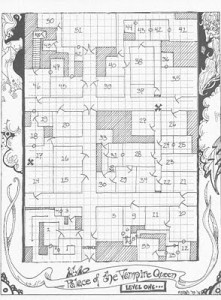Simpler Dungeon Design: Consider the Antagonists
Posted by Rampant Coyote on April 17, 2017
 Jeffro (of Appendix N fame) has a suggestion for easier dungeon design for old-school style dungeon delving.
Jeffro (of Appendix N fame) has a suggestion for easier dungeon design for old-school style dungeon delving.
DUNGEON DESIGN: Start with the Wandering Monsters
In some ways, what he’s really working through is encounter design. This was a bit of an emphasis in the late 3rd edition and 4th edition D&D dungeon design style of Wizards of the Coast, too, if you abstract it down enough. Although he takes this in a little bit of a different direction, which I like.
Besides just encounter design, he’s simultaneously coming up with variations and a list of antagonists. Then he considers how the players will interact with the antagonists, how they interact with each other, and how the players may disrupt these relationships.
The nice thing here is that while he’s planning out how these encounters might play out, the insistence on including it in a wandering monster table forces a different perspective on things, unlike the WotC approach. The WotC approach was very linear. The monsters are here, the obstacles are here, the special conditions are thus, and the players must succeed by accomplishing this. Jeffro’s approach requires the DM to be in a more interactive mindset. The party may bypass combat with bribes, threats, negotiations, stealth, you name it. It’s good for the DM to have at least a default plan… for all that the party tends to upend the best-laid plans, in practice with my own group, they stay within the lines more often than not. Just not when you expect them to…
Ultimately, it makes sense to me. Focus on the conflicts and the interesting challenges, not on the geography.
Filed Under: Design, Dice & Paper - Comments: 3 Comments to Read
Felix said,
Very nice! The details are too esoteric for me, but the basic concept rocks: “Start with what you want to “say” with the dungeon and then build everything else around that.” It’s called having a *theme*, and it’s vital in fiction writing, too.
Speaking of which, the same principle can be used to devise fictional cities: by considering how they form, usually as trading posts at the crossroads of two caravan trails, or growing around a port/fortress.
Good find!
Weekly Links #167 « No Time To Play said,
[…] articles for game designers: a brief one on how to choose content for a roguelike, and the other (via Jay Barnson) on a better way to design dungeons. Short version: just as wordlbuilding in general should serve […]
SENSOR SWEEP: Raffish and Déclassé, Freewheeling Roots, Terrible Purpose, and Chunky Salsa – castaliahouse.com said,
[…] Games) Simpler Dungeon Design: Consider the Antagonists — “The nice thing here is that while he’s planning out how these encounters might […]